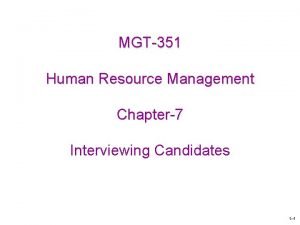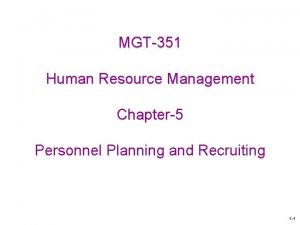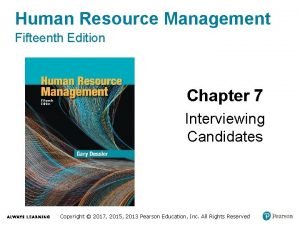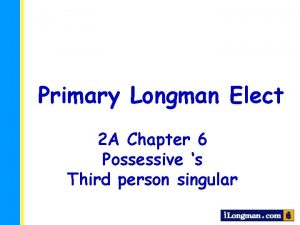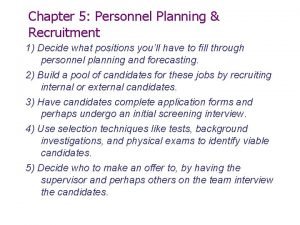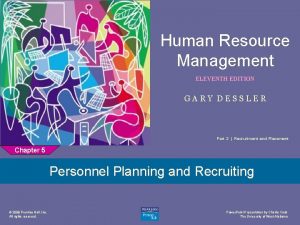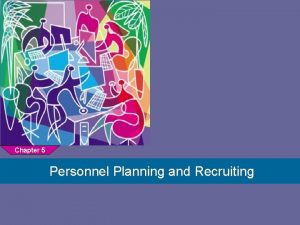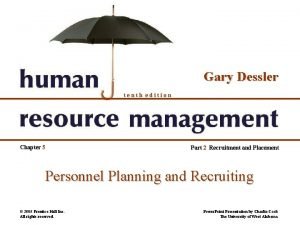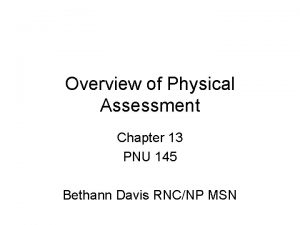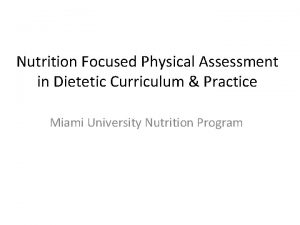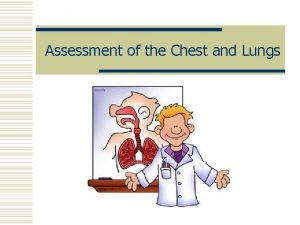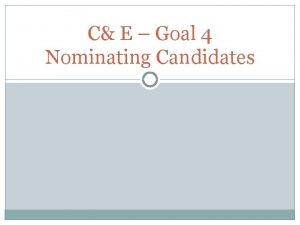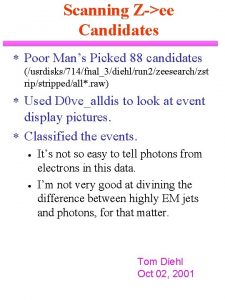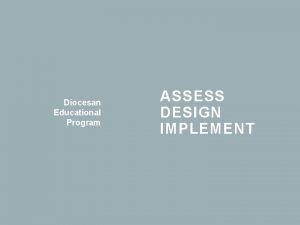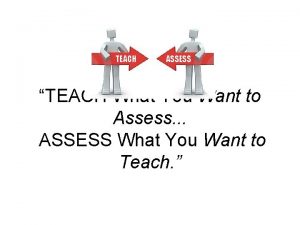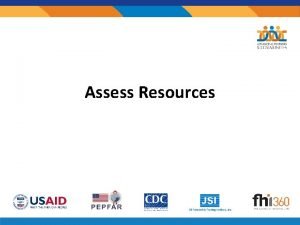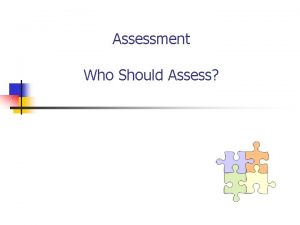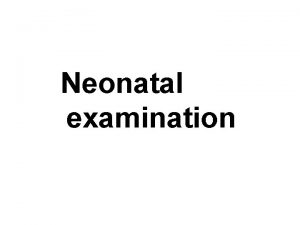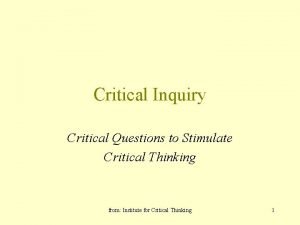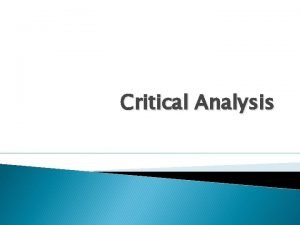Critical Research Study n n Assess the candidates
























- Slides: 24

Critical Research Study n n Assess the candidate’s ability to independently research, investigate and analyse a media topic and to present findings. Research in depth one of the nine topics in the area of audience and institution and to develop an independent critical response.

The Exam n n There will be two questions for each topic you must answer both. Question 1 = research Question 2= Analysis and preparation You are allowed to take in 4 pages of notes

QUANTATIVE n A TYPE OF RESEARCH BASED ON NUMBERS, STATISTICS AND OFTEN INVOLVES TABLES. IT MEASURES SOMETHING, SUCH AS VIEWING RATES, TIMEWATCHING TV ETC. IT USUALLY INVOLVES LARGE AMOUNTS OF PEOPLE

QUALITATIVE n EXPLAINS SOMETHING AND MY INCLUDE DISCUSSION AND ANALYSIS OF OPINIONS AND ATTITUDES. A MORE FOCUSSED GROUP OF PEOPLE IS USED.

METHODOLOGY QUESTIONNAIRES AND SURVEYS (THINK CAREFULLY ABOUT QUESTIONS AND THINK ABOUT WHO, WHAT , WHERE, WHEN, HOW) n INTERVIEWS n FOCUS GROUPS n

CONTENT ANALYSIS What are you looking for? n What texts will you use? n Will you use all of the text? n Categories or aspects of research n Logging research n Analysis n Reflection n

PRIMARY YOUR OWN ORIGINAL RESEARCH SECONDARY USING OTHER PEOPLE’S RESEARCH

Using Secondary Data n n n Use books, internet and contact firms Accurately reference everything you use For books: author, date, title, publisher For Internet: URL and date you accessed it Non-print based: director, title, broadcasting channel, date or broadcast

The Content of the Exam Question One: This will be about the methods of research that you have used to investigate the topic n Question Two A more general question based on an area of the topic n

You must show: n n n n n Proficiency is using range primary/secondary Selecting appropriate research Referencing of resources- accurate Relevant resources Findings are comprehensive Independence Sophisticated analysis with personal response Skilful comparisons of texts Specific examples to support arguments

Representation n n Way in which the world is interpreted and presented by the media. They do this through a series of signs It is important to remember that it is never the truth or objective but a re-presentation Remember that it is selective and edited Stereotyping

Ideology n n n Part of representation Belief systems The media is a powerful way of emphasising these and creating them

Hegemony n n The theory that people are influenced into accepting the ideology of a powerful elite who impose there ideology on the population. It argues that the reason these people rule is because the population allows them to In other words the media has to persuade us that it has our best interests at heart for us to accept them as dominant. This is a theory by Marxist critic Antonio Gramsci

Hypodermic Needle Theory n The media injects ideas into a passive audience, like giving them a drug.

Question 1 Accounts of the kinds of research undertaken, to include the following: n The producers, institution or industry concerned n Academic criticism n Popular criticism n Audience reception, including the candidate her/himself

How to structure essay Q 1: Introduction: Briefly outline the types of research that you have done. Use words such as primary/secondary, academic/popular, qualitative/quantitative

Main section Have sections on: n The institution n Academic criticism n Popular criticism n Audience reception You must: Discuss primary and secondary resources, relevant resources, detailed examples of your findings, accurate references.

Conclusion Sum up your research and tell the examiner what you found particularly useful and what you do not.

Question 2 Analysis and presentation of the research undertaken, to include the following: n The investigative process and the findings of the research n The presentation and development of an argument or thesis, with reference to research and textual evidence n Where appropriate, conclusions

Structuring a response n n n Introduction- give a basic response to the question that you will extend on in the essay Main section- decide on three/four main areas that you are going to discuss your findings of (related to question). With each one discuss the opinions of other (references), your own research with findings and give specific (referenced) examples of case studies etc that prove your findings- comparing examples in each section. PEE still applies Conclusion- Sum up your findings with reference to the question

Have you got…? n n n Primary research with conclusions Case study notes and your own conclusions and opinions Content analysis notes Academic criticism- with notes/own conclusions Popular criticism with notes/own conclusions Hypotheses with conclusions

Examiner’s report Do’s: n Have brief notes to jog your memory n Use personal researchespecially primary n Reference everything n Develop a series of hypotheses based around what you have studied with notes on your conclusions and references n Discuss one or two of these hypotheses in Q 2 to focus your answer n Use evidence to back up your ideas- compare different pieces of evidence Don’t: n Have long, prosaic notes n Use sources without referencing n Use only one example n Just write down everything that you know.

Guidance on Candidates’ Notes • Candidates are able to take 4 sides of A 4 research notes into the examination; these must be submitted with the candidate’s examination script. • The purpose of these notes is to serve as an aide memoire for the candidate, for detailed information, as below. • The notes, which must be hand-written by the candidate him/herself, should cover primary and • They should not contain essay plans or continuous prose. • On no account should additional sheets or materials be brought into the examination room, nor should the research notes be word-processed, printed, photocopied or typewritten. It is recommended that candidates collect their research findings carefully during the course of their Critical Research Study, which should then be selected and edited carefully at a reasonable period before the examination and presented as the final four sides of research notes.

Hypotheses n n n Now you have done research make up 3 hypotheses based on your research Give references and citations for evidence Your conclusions
 Critical semi critical and non critical instruments
Critical semi critical and non critical instruments Semi critical instruments in dentistry
Semi critical instruments in dentistry Presentation of candidates for confirmation
Presentation of candidates for confirmation Chapter 7 interviewing candidates
Chapter 7 interviewing candidates Personnel planning and recruiting
Personnel planning and recruiting Chapter 7 interviewing candidates
Chapter 7 interviewing candidates Script for recruiter cold call
Script for recruiter cold call The teacher has chosen candidates for my husband
The teacher has chosen candidates for my husband Forecasting the supply of inside candidates
Forecasting the supply of inside candidates Forecasting the supply of inside candidates
Forecasting the supply of inside candidates Forecasting the supply of inside candidates
Forecasting the supply of inside candidates Www.candidates.cambridgeenglish.org cs results online
Www.candidates.cambridgeenglish.org cs results online Forecasting the supply of inside candidates
Forecasting the supply of inside candidates Typical gd comprises of a small group of candidates
Typical gd comprises of a small group of candidates Recruiting yield pyramid
Recruiting yield pyramid Compare non-critical readers with critical readers.
Compare non-critical readers with critical readers. Tactile.fremitus
Tactile.fremitus Hr planning process
Hr planning process Physical examination definition
Physical examination definition How to assess alert and oriented
How to assess alert and oriented Navy orm matrix
Navy orm matrix How to assess edema
How to assess edema How to assess alert and oriented
How to assess alert and oriented Forms of retail organization
Forms of retail organization Normal ap diameter of chest 2:1
Normal ap diameter of chest 2:1



